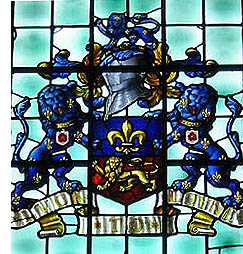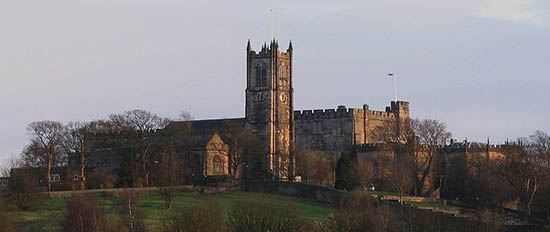TIMELINE: Lancaster
by Darcy Lewis
 Pre-5th century A.D. - Romans build three forts on the site of what is now Lancaster Castle.
Pre-5th century A.D. - Romans build three forts on the site of what is now Lancaster Castle.
Ca. 124 A.D. - Romans build small altar at Lancaster
Ca. 343 - The Romans are thought to have built a large fort at Lancaster.
5th century A.D. - Romans leave Britain and the forts fall into disrepair.
Ca. 630 - First church is built on site of Lancaster Priory.
Ca. 1066 - William the Conqueror gives Lancaster to Roger of Poitu in gratitude for his services in battle.
1086 - Domesday Book lists name as 'Loncastre' for a modern meaning of 'The Roman fort on the River Lune.'
1093 - Roger of Poitu establishes his military headquarters at Lancaster.
1094 - Benedictine Priory of Lancaster is founded.
12th century - Position of High Sheriff of Lancashire created.
Ca. 1150 - Normans build a stone keep to form the nucleus of Lancaster Castle.
1166 - Assizes first held at Lancaster.
1193 - Lancaster receives its first charter as a market town and borough.
1196 - First written reference made of a gaol at Lancaster Castle.
1206 - King John holds court at Lancaster Castle.
1253 - Records show that more than £250 was spent on constructing Lancaster Castle's curtain wall and gateway.
1265 - Henry III gives his son, Edmund, lands that had belonged to Simon de Montfort and Robert Ferrers, Earl of Derby.
1267 - These lands acquire the name of Lancaster, and Edmund becomes the first Earl of Lancaster.
1297 - Edmund's son, Thomas, inherits the earldom of Lancaster and extends his holdings via marriage.
1322 - Robert Bruce and Edward II visit Lancaster Castle.
1325 - Witches' Tower (originally called the Well Tower) is built.
1351 - Edmund's grandson, Henry, becomes first Duke of Lancaster.
1361 - John of Gaunt becomes Earl of Lancaster by marrying Henry's daughter, Blanche.
1362 - John of Gaunt becomes the second Duke of Lancaster.
1362 - First shipping bylaws for Lancaster were written.
1399 - John of Gaunt dies. Following his uncle's death, Richard II seizes the duchy of Lancaster, making it part of the properties of the monarch. This arrangement continues today.
Ca. 1400 - Either Henry IV or Henry V launches a rebuilding program at Lancaster Castle. Its most important accomplishment is the John of Gaunt Gatehouse, one of the finest of its type in England.
1460 - Edward IV visits Lancaster Castle.
1585 - Queen Elizabeth I rebuilds the upper story of Lancaster Castle's Norman Keep.
1612 - Trial of Lancashire Witches is held in Lancaster Castle.
1617 - James I visits Lancaster Castle.
1652 - George Fox, founder of Quakerism - first visits Lancaster.
1664 - George Fox is imprisoned at Lancaster for refusing to take the Oath of Supremacy.
1670s - First known voyage from Lancaster to the Americas occurs.
1715 - Jacobite army marches into Lancaster. They leave two days later for the Battle of Preston.
1729 - Robert Gillow begins making furniture from imported mahogany.
1736 - Lancaster ships begin transporting African slaves.
1740s - Gillows opens a London warehouse; improved distribution dramatically increases the firm's national reputation.
1742 - Robert Gillow becomes an Indies trader.
1745 - Bonnie Prince Charlie briefly occupies the town during the Jacobite Rebellion.
1749 - Lancaster's Port Commission is established.
1764 - Lancaster's Custom House is completed.
1770s - Lancaster native artist Joseph R.A. Farringdon returns from London to paint Lancashire and the Lake District.
1783 - Architect Thomas Harrison completes construction on new Town Hall for Lancaster.
1788 - Gaoler's House is erected at Lancaster Castle.
1788 - Architect Thomas Harrison is commissioned to design a Crown Court and Shire Hall at Lancaster Castle.
1792 - Construction begins at Lancaster Castle on a prison for female felons.
1794-1796 - A prison for male felons and "accommodations for debtors" are built at Lancaster Castle.
1796 - Lancaster Castle's medieval Great Hall is demolished.
1798 - Workers complete construction of Harrison's Crown Court and Shire Hall.
1800 - Public executions are moved from Gallows Hill on the moors to the Hanging Corner at Lancaster Castle.
Ca. 1800 - Lancaster becomes the third busiest port in England, after London and Bristol.
1801 - Noted cabinetmaker Gillow of Lancaster makes the Grand Jury Room's table and chairs for £7 each.
1802 - Joseph Gandy provides designs for decorative elements of the Crown Court and Shire Hall, including traceries, seating and canopies.
1803 - Lancaster martitime insurance broker Gideon Yates is imprisoned for debt; after prison, he becomes a professional painter specializing in scenes of Lancashire.
1811 - The last time a convicted prisoner's hand was branded with M for malefactor in Lancaster's Crown Court.
1816 - Artist J.M.W. Turner paints his most famous pictures of Lancaster as part of his commissioned work 'A General History of the County of York.'
1817 - Artist Gideon Yates paints his last scenes of Lancaster before moving to London.
1821 - Joseph Gandy designs and builds a 5-story, panopticon Female Penitentiary at Lancaster Castle. It is still used today by male prisoners.
1822 - John of Gaunt's statue is installed above the gatehouse that bears his name.
1835 - Liverpool receives rights to hold assizes, hastening Lancaster's decline as an assizes center.
1846 - Prince Louis Napoleon visited Lancaster Castle.
1846 - The Lancaster & Carlisle Railway opens Carnforth Station.
Ca. 1850 - The River Lune begins to silt up, encouraging citizens to turn to manufacturing.
1852 - Queen Victoria visits Lancaster Castle.
1857 - Ulverstone & Lancaster Railway reaches Carnforth Station.
1865 - In the last public execution to be held at Lancaster Castle, Stephen Burke is hanged for murdering his wife.
1866 - The national Bankruptcy Act ends the centuries-old tradition of holding debtors at Lancaster Castle until they could pay their debts.
1880 - London & North West Railway takes over lines of the former Lancaster & Carlisle Railway, including Carnforth Station.
1890 - Norman curtain wall is discovered at Lancaster Castle during excavation.
1904 - Lord Ashton begins construction on Ashton Memorial.
1906 - Model of Ashton Memorial exhibited at the Royal Academy in London.
1909 - Lord Ashton completes Ashton Memorial, "England's grandest monument."
1912 - George V visits Lancaster Castle.
1916-1918 - Lancaster Castle is used to house German POWs.
Late 1920s - A total of 64 Roman coins are discovered near Lancaster.
1931 - The original plans for Lancaster Castle's Great Hall and dungeons are discovered.
Ca. 1940 - Two cannons and the railings around Lancaster Castle are melted down to make bullets.
1954 - Lancaster Castle is returned to prison use once again for low-priority criminals.
1965 - Construction begins on Lancaster University.
1966 - Lancaster University begins partial operations.
1968 - Students move in to Lancaster University.
1971 - Lancaster assizes are demoted to status of a third-tier Crown Court.
1975 - Criminal trial of the alleged IRA pub-bombers the Birmingham Six is held at Lancaster Castle's Shire Hall.
1988 - An excavation for Mitchell's Brewery includes the discovery of 34 Roman coins.
1999 - Queen Elizabeth II visits Lancaster to mark the 600th anniversary of the Crown's ownership of the duchy.

Related Articles:
- Lancaster, by Elizabeth Ashworth
- https://www.timetravel-britain.com/articles/towns/lancaster.shtml
- Hidden Churches of Lancashire, Manchester and Liverpool, by Louise Simmons
- https://www.timetravel-britain.com/articles/churches/lancashire.shtml
- Pace Egging - A Lancashire Tradition, by John Ravenscroft
- https://www.timetravel-britain.com/articles/history/pace-egging.shtml
- Wakes Weeks: From the Saints to the Sea, by Elizabeth Ashworth
- https://www.timetravel-britain.com/articles/history/wakes.shtml
Darcy Lewis is an award-winning freelance writer whose articles have appeared in Writer's Digest, HGTV Ideas, Home, and the Chicago Tribune, among many other publications. Much of Darcy's knowledge of British history can be traced to her work as a history major specializing in pre-modern England at Brown University in Providence, RI. But her passion has deeper roots: Darcy's English mother, who is an endless treasure trove of stories about "how we do things at Home."
Article © 2005 Darcy Lewis
Images courtesy of Wikipedia.org
| 